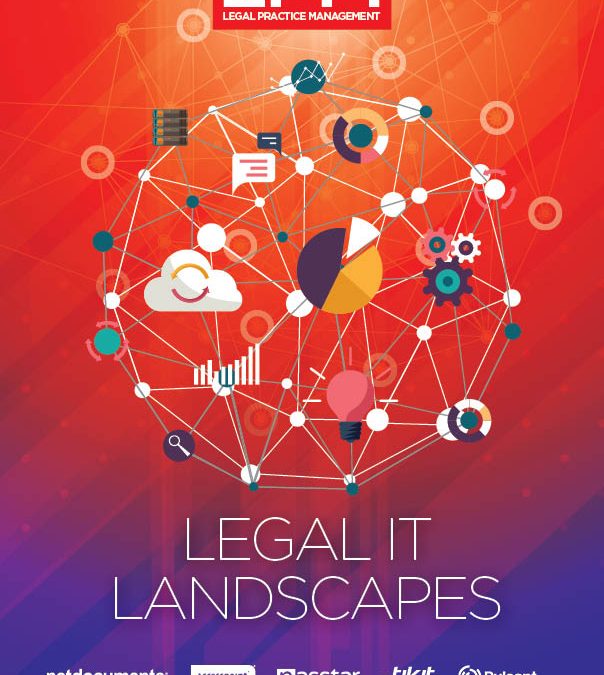We attended – and facilitated – at a most informative Legal Practice Management (LPM) event yesterday, where Rupert Collins-White analysed the results of the 2018 Legal IT Landscapes, research aimed specifically at mid-sized law firms. More than 80 firms responded to the survey – the results are probably fairly representative of the market as a whole.
Interestingly enough, there were repeated mentions of, and considerable interest expressed in AI and the “hype” technologies, by far outranking mentions of more “old tech” systems, such as case management, practice management and document management. Most noticeable was the change of focus from the more boring aspects of tech, such as infrastructure and last year’s buzzword, “cloud” and a change of focus to the application layer particularly in areas where business processes can really benefit from technology.
But does this match the reality of what firms are actually doing, of where they are spending their tech investment? Further questions and analysis suggest not. By far the largest percentage of IT budgets (72%) seem to be spent on business as usual, and keeping the lights on. Furthermore, even though AI may be this year’s buzzword, there is a lot of misunderstanding and misconceptions around AI, what it actually IS and what it can deliver right now.
When the round-table discussions started it became more apparent what people were focused on. The Infrastructure stream had the least people, PMS the most with AI slightly behind. This we took as an indication that the “application” infrastructure was the main focus.
We at Baskerville Drummond adopt an alternative approach. We suggest that firms – particularly in the mid-sized market where every pound invested should be made to count –should focus on their own business strategy and goals, and should take a long hard look at how their technology investment decisions will support their business goals. This calls for a tight alignment between the practice goals and the technology strategy, and a structured and prioritised approach to implementation. By definition, the first questions should be what are your business goals, do you have an IT Strategy and does it support those goals? If not, the first steps should be to perform a gap analysis and agree your technology strategy.
We were surprised by the limited mention of “infrastructure” and “Cloud” within the report. Does this mean that it is a question of “been there, done that” and that firms are confident that their infrastructure can support their other tech initiatives? Or have they already moved to some form of “Cloud” and are happy with their providers? Sure enough, “Cloud” is no longer sexy, and mention of infrastructure has always caused practice managers’ eyes to glaze over. Yet these are the fundamental building blocks, the foundation to whatever other IT and tech reliant projects you may undertake. Neglect it at your peril. At the very least, review your infrastructure and make sure that it can fully support your business for at least the next three years, if not longer.
From the report, it is obvious that practice, document and case management systems are still high on the agenda for reasons of both efficiency and competitiveness. This is indeed no surprise, and accords with our own market experience. Major factors influencing this focus are:
- many firms, between 40 and 60%, are still on systems where end of life has been announced. Focusing on your core business systems is therefore not an optional luxury, but a business necessity
- market forces and client demand underpin a drive for efficiency and more streamlined business processes – leading to improved profitability and competitiveness. The perception – and potentially the reality – is that the current generation of practice, document and case management solutions will better facilitate these goals.
We suggest that for a large proportion of firms in the mid-sized market, the main focus of their technology investments should be directed at these two areas for maximum business benefit.
Which is not to say that the more innovative technologies – those facilitating Smart working, AI, blockchain and the rest – should be neglected. Firstly, many applications which are perceived to be “AI” are nothing of the sort – they are tried and tested and are proven to deliver results. Think of document automation, document review (notably eDiscovery), speech recognition and many others. We suggest that these should be considered first, before investments in the more experimental aspects of AI are contemplated. Mid-sized firms need to marshal their tech pounds and pennies carefully, before engaging with the experimental.
There is no doubt though that in the medium to longer term, as AI matures, it will have a radical impact on the practice of law and legal business. It would be foolhardy to neglect the future impact of these technologies. Several of the speakers at the LPM event suggested that mid-sized firms should form consortia – thus spreading the risk – to engage with AI development. This is a view which we at Baskerville Drummond fully endorse. We are already in the early stages of planning round table events for later in 2018, to which we will invite our clients and other interested parties, specifically to explore mutually beneficial collaboration between firms in the area of AI.
If you would be interested in getting involved in this group please let us know by completing the following form.
[wpforms id=”3055″ title=”true” description=”true”]







